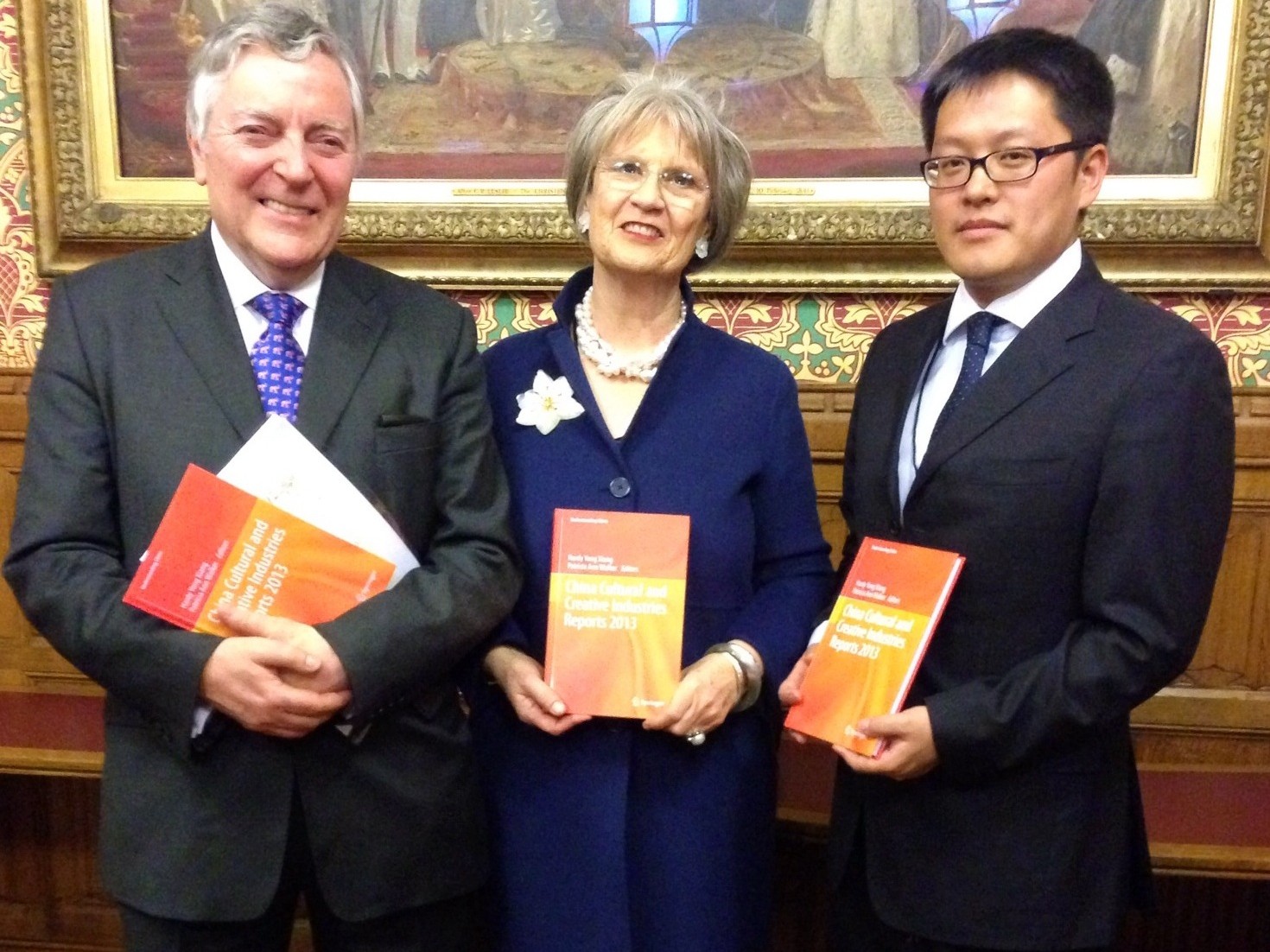I made very interesting visit to the Confucius Institute in Edinburgh to talk about China the UK and the Creative Industries. I have now spoken on the same subject to the LSE’s Confucius Institute for Business.
Britain and China: a Creative Partnership : LSE Confucius Institute Lecture
27 November 2014
Tonight’s lecture brings together two great interests of mine: China and our creative industries, by which I mean the whole range of cultural activity including the creative visual and performing arts and the content industries.
Tonight I want to talk about the relationship between China and the UK in the creative industries and demonstrate that we now have great opportunity for a strong creative and cultural partnership between China and the UK if we seize the moment.
The UK has the largest creative sector in Europe. This includes film, TV, video games and publishing, architecture, art, design, fashion, film, video games, music and software.
- The UK’s creative industries are now worth £71.4 billion per year to the UK economy and represents 5.2 per cent of the UK GDP.
- The sector a whole is growing at twice the rate of the rest of the economy and it now accounts for almost two million jobs.
But also advertising, Exports are worth £16 billion annually, or 4.3 percent of all UK goods and services exports.
In London they represent 16% of the local economy.
"Best practice is out there for us to share with our partners. I am sure that there are strong partnerships to be made between British companies and cities and Chinese municipalities and enterprises in developing and managing space suitable for creativity of all kinds."
— Lord Clement-Jones
A crucial factor in this growth has been the tax treatment of film production which has supported more than £5bn of investment into British films and contributed to a 70 per cent increase in the film production workforce since its introduction This was followed by high end television and animation and later the video games relief. The new theatre production tax relief and patent box will have a major impact too.
As Innovate UK formerly the Technology Strategy Board say in their creative Industries strategy document last year, “The UK has a share of around 5% of the global export market for creative goods. It is a broad and diverse sector which ranges from advertising and crafts to performing arts and video games. As well as their direct economic value, these industries play an important role in catalysing innovation across the wider economy, through the products and services they provide, but also as means of originating and spreading new ideas, knowledge and ways of working. “
As they say, major trends of digitisation and convergence and have all contributed to the emergence of a digital landscape of increased complexity.
The strength and depth of the UK’s creative industries is a huge advantage for Britain. In the UK we have huge expertise not just in the creative industries themselves but in delivering creative clusters , media hubs, film studios and the like. Increasingly our creative sector is a vital aspect of our international trade and investment especially our films and our TV content.
Britain has a global position of strength in the Visual Effect industry (VFX) as was seen in the movie Gravity with Sandra Bullock and George Clooney! This built on the success of the Harry Potter franchise, War Horse and Dark Knight.
Seventy percent of international advertising agencies have their European headquarters in the UK. The UK’s advertising system sets the standard in successful self-regulation, being governed by codes of practice that are designed to protect consumers by ensuring that advertising is legal, decent and truthful.
UK fashion designers export 66 percent of the clothing they produce. The fashion industry contributes over £37 billion annually to the British economy and employs over a million people.
Famous and creative brands such as Burberry, Jaguar, Bentley, Aston Martin, Land Rover not mention Chivas Regal and Johnnie Walker are highly sought after by Chinese consumers.
The UK is home to over 40 percent of Europe’s electronic design industry. Samsung’s European design centre is located in London for example. Huawei has invested in a design centre here too.
There are now more than 1,500 companies in Tech City in London. 70,000 people are now employed there and there were15,600 startups there in each of the past two years.
The UK is the highest net exporter of computer games and information services in the G7. UK-made computer games account for 12 percent of the world games market. The UK boasts 26 of the world’s most profitable games studios. All major international studios have UK-based developers including Microsoft, Sony, Disney and Nintendo
Our architects generate in excess of £700 million in revenue each year.
The UK is the global leader in TV formats, accounting for 53 percent of all exported format hours in the worldwide market, compared to 14 percent for the USA.TV Exports have also flourished; the value of UK TV exports increased by 127% between 2006 and 2009 – putting us second only to the US in terms of international sales.
British programme makers are already making inroads as Chinese viewers increasingly stream UK content through local platforms.
Chinese viewers all seem to be watching Sherlock and Downton Abbey! The BBC’s third series of Sherlock received almost 70m views on digital platform Yoku. The Chinese viewing figures of 160m per episode in particular for Downton Abbey are extraordinary.
Of course everybody now thinks we Lords live like that! I’ve even seen adverts in China for courses in British etiquette!
The UK Creative Industries Council has now launched CreateUK –the Creative Industries Industrial Strategy which sets out ambitious plans to increase the number of UK creative companies that export around the world.
China’s Creative Industries
Something very important for creative industry is also happening in China. In the last two years I’ve visited a wide variety of cities including Beijing, Shanghai, Hangzhou, Hong Kong, Shenzhen, Chengdu, Qingdao, Xiamen, Suzhou, Taiyuan and Nanjing.
In all of them-whether in discussion with business people, national, provincial or municipal officials or students and academics- I’ve seen total agreement about the new importance to China of creativity and the creative industries.
The sector has been growing at more than 20 percent a year since 2004.
There are more than 50,000 cultural and creative enterprises in China, of which 8,000 are state-owned. The most profitable sectors have been advertising, IT services, tourism, indoor entertainment, cable TV services and publishing.
In business the emphasis is now on creativity. This is very much reflected in the 12th 5 year plan which takes us up to next year. It marked an important new approach where creative and artistic skills are being highly valued.
As the former Chairman of CBBC Sir David Brewer said in UKTI’s publication, “Creative Industries in China: Opportunities for Business” published in 2011 in the year the plan was adopted.
“Having largely relied on imports of foreign design and technology for many decades, China has woken up to the need to develop its own creative abilities. China’s move from ‘Made in China’ to ‘Designed in China’ is creating many and diverse opportunities for British companies.
Whether designing mobile phones or iconic new buildings, producing television documentaries or mobile applications, China’s creative sector is a field where British companies, both small and large, can really do well.”
The phrase: “Moving from Made in China towards created in China” indicates a desire to move from the hardware driven approach of manufacturing and assembling to others’ design towards a higher value added economy of conceiving the concept and design elements as well, a move towards encouraging creativity and innovation.
All this is well documented in Shaun Rein’s book “The End of Copycat China”.
Last year China overtook Japan to become the second largest film market worldwide, far bigger than Britain or India, and is set to overtake the US by 2020. 3D is especially popular in China. Just look at the recent success of “Transformers: Age of Extinction”.
Every day in China last year, 10 new cinema screens were added to the country’s existing 13,000 and this will continue. China is home to the largest film studios in the world and its film industry grew 36% over the past year and is now worth £1.7bn annually.
Digital media, animation and the games industry have all grown very fast in China. In 2013, the value of the Chinese animation industry reached £3billion an annual growth rate of 25%.
Then of course there is the massive Chinese publishing industry seeking opportunities outside China. In 2012 we had a very successful London Book Fair with China’s publishing industry as the key focus.
Partnership
I would argue strongly that the time is ripe for “Creative Britain” to partner with China to promote creativity and growth both inbound and outbound in a variety of ways
I have seen real enthusiasm in China for partnership with British creative industries and creators. This enthusiasm for coproduction, partnership and investment in the tech and creative industries is now particularly alive among younger business people in China.
The UK in particular is in a great position to promote itself as the best possible creative partner for China. UK creativity is highly marketable, award-winning and sought after by global business.
In 2010, the UK Pavilion at the Shanghai Expo made a huge impact. The Chinese took genuine pleasure in the success of the British pavilion and took to heart what we call the seed cathedral and they called the “Dandelion”The Thomas Heatherwick designed UK Pavilion not only won the top prize; it cost a fraction of other nations’ pavilions and was named one of the 50 best inventions of 2010 by Time magazine.
In 2011, Beijing Design Week chose London to be its first “honoured guest city” and the UK was represented at the event by some of our finest designers.
The London Olympics were a huge boost to perceptions of Britain’s creativity and creative heritage when we took over the Olympic torch from Beijing.
The London Olympics were followed by the “GREAT ” campaign. On his visit to China in October last year the Chancellor Chancellor George Osborne hosted a ‘Creativity is GREAT’ reception to showcase British innovation, tech and creative industries and encourage Chinese creatives to experience what Britain has to offer.
And to cap it all guests were greeted by the waxwork of royal couple William & Kate – to mark the launch of Madame Tussauds in Beijing. That’s salesmanship for you!
Since the PM visited China last year Buckinghamshire-based Pinewood Studios has signed an agreement with Wanda to advise on the design and construction of a new film and television studio complex in Qingdao. Once completed, it will be one of China’s largest film and TV studio facilities.
London-based Silvergate Media has signed a deal with CCTV to broadcast its children’s TV programmes ‘Octonauts’ and ‘Peter Rabbit’ in China.
If our creative businesses can get the basics right, there is no reason why they should be deterred or frightened by emerging markets such as China but we really need to understand how the Chinese market works.
A report published n 2012 by Nesta (formerly the National Endowment for Science, Technology and the Arts) “Crossing the River by Feeling for Stones: a new approach to exporting creative content to China?” mentions that a particular stumbling block in China for UK creatives is the uncertainty around local demand for their products.
They highlight the danger that the UK is not investing in building the relationships with Chinese consumers now that could pay handsomely in the future, if and when the business models have been worked out.
NESTA point out that success depends on a delicate balancing act between the global and the local and describe the runaway success of the Kung Fu Panda films in China, that were produced by US studio DreamWorks Animation and featured Western actors, but mixed references to martial arts films with classic legends to offer an imaginative and spirited take on Chinese culture.
Harvard Business Review summarizes the key characteristics of the Chinese consumer as:
- Price sensitive, but brand conscious
- Lacking trust, that’s why Taobao’s business model is very successful versus western brands
- The product of the one child policy, which means children related goods and services play a central role
- Increasingly informed, sophisticated and active, many Chinese travel overseas to buy genuine branded products
The biggest media phenomenon in China at this time is the internet. China remains a controlled society with regards to conventional mass media.
By contrast information circulates very rapidly on the internet because practically and logistically there is only so much that the government can control. The internet also carries significant credibility and people more readily believe in information found on the internet, than in television advertisements.
It is clear that UK tech/ creative digital sector will be unable to exploit its strengths unless it becomes more familiar with the way Chinese consumers access online content.
E-commerce continues to grow at an outstanding rate in China and has now reached $1.4 trillion. In fact Alibaba through it’s Tmall and Taobao brands has become the world’s largest online retailer, selling more than $170bn in goods in 2012, more than eBay and Amazon combined.
Any marketer in China should be developing a strong e-commerce strategy as a brand’s future market share will inevitably be linked to its online sales given current trends.
How many European here present for example know that Tuesday 11th November was Singles’ day in China, a day that ecommerce companies have turned into the world’s biggest for online shopping.
Weibo is China’s version of Twitter, Alibaba is its eBay and Baidu is a search engine offering a similar service to Google, not to mention Wechat which is now being adopted by Western teenagers! They are now gatekeepers to the Chinese online economy. Who needs Facebook, Google, Twitter, EBay and Tumblr?
There are different impacts depending on different generations.For an important generation the one-child policy plays the most critical role shaping in shaping consumer and psychological behaviour .
Then there are the conclusions of a fascinating recent paper China’s Creative Imperative, by Kunal Sinha,
He identifies not only that there is an explosion of creativity in China which pervades every class of society and evidence that China has all the necessary conditions and ingredients to transform itself from ‘made in China’ to ‘created in China’ but also that there are different impacts depending on different generations.
The four generations he cities are the:
- In Between generation (born in the sixties)
- Open Door generation (born in the seventies)
- Take Off generation (born in the eighties)
- Flying Star generation (born in the nineties)
The In Between generation are most affected by the old China because they experienced significant hardship during the Mao Zedong era and this experience is translated into a feeling that they have ‘missed out’ and has seen them become ‘strivers’.
The Open Door generation was part of the transformation of China and the first middle class to be produced on the continent. The Take Off generation is the first to experience the effects of the one child policy designed to limit population growth, and they are often referred to as “the new strivers”. The Flying Star generation is much freer than their ancestors, take greater risks and largely believe that “I am who I am”.
Among the Take Offs, he says that the one-child policy plays the most critical role shaping in shaping consumer and psychological behaviour As the first “one child” generation, this generation faced unexpected opportunities as well as stress and challenge. The only child is the pivotal focus of the family, and they are afforded the very best of everything. Because of this, the impact of western culture, brands and globalization has been stronger and has resulted in a global view amongst this generation.
Outward bound investment
I have been very impressed in recent visits to China by the new emphasis being placed by organisations such as UKTI, CBBC, The British Council the FCO and London and Partners on the creative industries and that they are seeking openings for British creative industry to partner in China.
The NESTA report on creative exporting mentioned earlier shows the opportunities but also highlights that there are many regulatory hoops you need to jump through when working in China.
Just take the film industry for example. China’s ticket sales are too big for major western studios to ignore, as films distributed in China can potentially make more than Hollywood productions released internationally. But breaking into China’s box office isn’t as simple as dubbing western productions or adding subtitles.
SARFT –the film regulatory body-has strict control over the content to be broadcast. Chinese authorities view all films before release and have a significant effect on content. For example Django Unchained was released in China as a foreign film, but pulled from cinemas minutes into its screening, reportedly because of background images of nudity.
China still has an annual film quota for the number of revenue-sharing foreign films accepted for full distribution rights. Although that rose from 20 to 34 last year, the extra spots are reserved for 3D, Imax or animations, and competition is fierce.
There have been a number of very important recent developments bringing us closer together.
The Film Co-production Treaty negotiated by the BFI and signed earlier this year will give Chinese-led productions access to UK Film Tax Relief and the BFI Film Fund. Eligible co-productions will not be subject to China’s quota on foreign films. This will lead to real partnership between UK and Chinese filmmakers.
So far 2 projects have been approved by SARFT under the treaty, with BBC Worlwide being one of the early producers involved.
Under the new agreement filmmakers will also be granted a larger share of box office receipts. The new agreement also promises to strengthen transparency.
In particular, rights owners will enjoy access to censorship decisions, ensuring that licence deals cannot be terminated willy–nilly or renegotiated by the back door without rights owners having an opportunity to discuss problem areas with censors or inserting alternative films into previously signed import agreements.
This is a considerable advance on what are called assisted coproduction –essentially pure location services agreements. The new type of coproduction will develop material for the local as well as international market. There will need to be content relevant to the Chinese way of life and culture and a strong Chinese percentage of the cast under the terms of the treaty to qualify.
Then there is the MOU signed around the same time between CCTV and PACT exploring potential areas of collaboration with UK independent producers which is very promising.
In June I took part in the third Technology Innovators Forum in Qingdao, TIF-IN a major event promoting our UK creative industries . At TIF-IN, Vince Cable our Business Secretary launched the Global Digital Media and Entertainment Alliance with China which will promote long term relationships in the digital media and entertainment sectors,.
The intention is that this will encourage collaboration on delivering the next generation of products in music, film, digital and video games, deliver a massive boost to UK creative exports and position the UK as the favoured location for inward investment, creating more sustainable jobs and building a stronger economy.
It will greatly benefit the UK’s creative industries and already Qingdao’s West Coast New District has signed an MOU with UKTI in London this month to cooperate in building an International Digital Entertainment Port.
TIF-IN itself encourages collaboration on delivering the next generation of products in music, film, digital and video games and brought together the most exciting Chinese and British creative technology companies with high profile political, financial and entertainment leaders.
Adopting a strategy that Chinese businesses in other sectors have pursued so successfully to develop their technological and managerial capabilities, 37 Chinese film companies are also being encouraged to agree joint ventures with leading foreign companies where Chinese companies have a majority stake.
Pinewood Shepperton, home of James Bond, for instance announced a joint venture with Chinese media group Seven Stars in April. The chief executive of the British Film Institute, Amanda Nevill, is now looking into a partnership with the Beijing film archive and creating a BFI channel on China’s version of YouTube.
The China Cultural Industry Investment Fund gives special support to sectors including entertainment, animation and digital games, TV, film production and distribution, publishing, cultural exhibition and internet media.
Generally however despite –or maybe because of it- doing business in China requires a strong network of support. Partnerships must be embedded within a larger strategic vision, on a long term basis, not undertaken on a purely project–by–project basis.,
Consumers and business may now be increasingly online in China but as ever building strong relationships is still where the future still lies in China!
"100,000 or so Chinese students in the UK bring huge benefits to our higher education institutions and their host towns and cities. They comprise 26% of all international students."
— Lord Clement-Jones
Creating Links between Hubs
In addition it is clear that there is a real role for collaboration between the UK and China in developing creative industry hubs or clusters in China and the UK.
Our cities, have done much to turn themselves into creative hubs. We have Media City in Salford, Manchester, which now contains the main studios of the BBC. Manchester Airport City Enterprise Zone is becoming a northern digital hub with the aid of £800m of Chinese investment.
We have film studio developments such as Pinewood Shepperton-where the James Bond films are made- or such as Warner brothers Leavesdon-where the Harry Potter films were made and where there is now a superb Studio Tour incidentally!
We have film, photography and production of video games in Brighton and special effects in Dundee.
There is no doubt that in China they can benefit from this kind of experience of developing and managing space suitable for creative enterprises.
Tech City in East London is emerging as a potential rival to Silicon Valley in the US, with Vodafone, Google and Facebook taking space.
Now some major Chinese technology companies are becoming involved and committing to investing in the long-term future of the area. I have mentioned Manchester airport City Enterprise Zone earlier where significant investment by Beijing Construction Engineering Group is taking place.
Best practice is out there for us to share with our partners. I am sure that there are strong partnerships to be made between British companies and cities and Chinese municipalities and enterprises in developing and managing space suitable for creativity of all kinds.
Leading educational institutes have set up research centres and have been engaged in developing policies and plans for industry cluster mapping on behalf of the government.
Certain cities in China are successfully turning themselves into creative hubs. Beijing is home to more than one million creative professionals, while other leading cities in the sector include Shanghai, Hangzhou and Shenzhen. Then of course there are plans for the new West Kowloon Cultural District in Hong Kong.
Just look at Hangzhou for example, the capital of Zhejiang province. The annual average growth rate for radio, TV and the film industry is currently over 20 per cent and it is committed to becoming a national digital TV industry base. There are 200 TV and film production companies in Hangzhou.The Hangzhou Municipal Government are determined to turn it into the ”animation Capital of China”.
Of course we have had a number of successful Chinese film festivals and conferences here in London. We are now all looking forward to the Screeen China Summit in December.
On the inward investment side what I hope will become an increasingly typical example is Rekoo. Rekoo is Asia’s largest social gaming company and recently announced that is setting up a base in London’s Tech City, the first high-profile Chinese technology company to do so. It currently has 15 million daily PC gamers and 10 million daily smartphone gamers, predominantly located in China.
Intellectual Property
We of course all need to make sure that creators are able to monetize and receive proper reward for their works and the skills that they have and the partnerships and collaborations they enter into.
Intellectual property protection through copyright enforcement is a subject of increasing importance in the digital age.
In previous times we did not necessarily have a common agenda with China but with much more intellectual property now being created in China between us we can work in partnership to protect it.
Working in dialogue between the Chinese government and UK intellectual property experts, together we can make progress towards better intellectual property protection and enforcement.
In China the IP protection regime is rapidly changing as Chinese homegrown IP grows in importance. We need to stay abreast of the new business models but all to a greater or lesser extent depend on good IP protection. We must ensure reform in China and elsewhere is timely to enable creative content to be exploited.
Both on the regulatory and legislative reform side and the development of education of the public and others in the value and importance of IP to the creative industries are vital both for their future viability and in their ability to deliver quality content.
For some time now we have had an expert IP attaché in Beijing giving regular updates on the many welcome copyright developments in China .
I am delighted too with the MOU signed between our China Britain Business Council Alibaba designed to protect and enforce intellectual property rights on property sold through them..
Education Links
There is also a common recognition that our UK centres of creative education are world beating.
What is needed for SME’s to take the plunge into China are effective cultural and business relationship bridges. One of the key ways of doing this is through Chinese alumni of UK universities. Cultural and educational exchange is vital if we are to nurture creativity in both our countries.
I am sure that this audience will agree will both these propositions!
Student alumni are a growing and important source of soft power for the UK and cultural bridge for British business. We need to ensure that our strong international links with China and Chinese students and postgraduates thrive. LSE is blessed at both postgraduate and undergraduate level with a much higher than average percentage of Chinese students and I understand now stays in touch with at least 4000 Chinese alumni.
There is a growing recognition that our centres of creative education can partner together. I see there is a strong LSE link with Tsinghua University, Beijing and an annual LSE China conference is held there.
Our UK higher and further education sector make a major contribution to the development of talent and skill for our UK creative economy. Some 16% of our students are engaged in courses relevant to the arts and the creative economy.
Many of our universities and further education institutions make a unique contribution. They represent hubs for innovation and centres for research. They engage with industry players, facilitate connections with creative SME’s and build networks. Many of them have important partnerships with cultural institutions such museums and galleries
We in Britain want to attract the best creative talent possible, both from China and elsewhere. We have increasing numbers of Chinese students studying here in a whole variety of creative skills, art, design, film, animation and so on.
We must however make sure that the student experience for Chinese students in creative skills in the UK is excellent and we create and tap into networks which they have when they leave. We need to create more paid.0 internships for Chinese students in the creative industries and the arts.
To its credit the British Council has worked with Chinese partners to successfully organise the first “Sino-UK Higher Education Cooperation in the Creative Media Industry” this last year. The programme has facilitated the successful establishment of strategic partnerships for a new media collaboration between a number of Chinese and UK universities.
Visa policy to date as regards Chinese students, appears to have taken no account of the balance of risks and rewards involved. 100,000 or so Chinese students in the UK bring huge benefits to our higher education institutions and their host towns and cities. They comprise 26% of all international students.
The sooner the Government sees sense and excludes students from the immigration figures the better it will be for the health of our Higher Education Sector.
There are some bright spots on the Visa front however. To attract elite global entrepreneurs working in the digital technology sector we opened an Exceptional Talent visa route in April 2014. This will provide an immigration route for individuals with a proven track record in developing successful businesses or creating new innovations in the technology sector.
So in conclusion ladies and gentlemen I hope I have successfully illustrated that the creative industries in so many ways offer China and the UK massive opportunities for effectively working together to our great mutual benefit.
I hope that whether we are in public service, academia or business we can all successfully rise to the challenge!
18th July 2015
Lord C-J debates the future of the BBC
15th December 2014
Launch of China Cultural and Creative Industries Reports 2013
1st December 2014
Happy New Year of the Horse!
23rd December 2013






